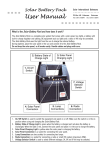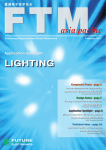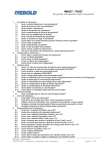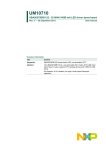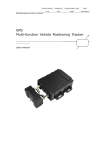Download UM10384 - NXP Semiconductors
Transcript
UM10384 UBA2028 CFL 18 W, 230 V dimmable reference board Rev. 03 — 20 July 2010 User manual Document information Info Content Keywords UBA2028, CFL, TRIAC dimmable, charge pump Abstract This document is a user manual for the 18 W, 230 V mains dimmable CFL reference board based on the NXP Semiconductors UBA2028. UM10384 NXP Semiconductors 230 V dimmable reference board Revision history Rev Date Description 03 20100720 Third issue. Modifications: • • All illustrations updated to revised AQL standard. Section 10 “Legal information” updated. 02 20100215 Second issue 01 20091014 First issue Contact information For more information, please visit: http://www.nxp.com For sales office addresses, please send an email to: [email protected] UM10384 User manual All information provided in this document is subject to legal disclaimers. Rev. 03 — 20 July 2010 © NXP B.V. 2010. All rights reserved. 2 of 15 UM10384 NXP Semiconductors 230 V dimmable reference board 1. Introduction WARNING Lethal voltage and fire ignition hazard The non-insulated high voltages that are present when operating this product, constitute a risk of electric shock, personal injury, death and/or ignition of fire. This product is intended for evaluation purposes only. It shall be operated in a designated test area by personnel that is qualified according to local requirements and labor laws to work with non-insulated mains voltages and high-voltage circuits. This product shall never be operated unattended. The UBA2028 230 V mains dimmable reference board is a Compact Fluorescent Lamp (CFL) driver for a 18 W CFL burner. The maximum input power is 18 W, and it can be dimmed using a TRIAC dimmer. The dimming range reaches down to 10 % of light output. 2. Features 2.1 IC description UBA2028 is a monolithic integrated circuit for driving electronically ballasted fluorescent lamps. The circuit is made in a 650 V Bipolar CMOS DMOS (BCD) power-logic process. It provides the drive function for the two discrete power MOSFETs. Besides the drive function, the IC also includes the level-shift circuit, the oscillator function, a lamp voltage monitor, a current control function, a timer function and protections. The IC includes: • • • • • • • • • Adjustable preheat time. Adjustable preheat current. Current controlled operating. Single ignition attempt. Adaptive non-overlap time control. Integrated high voltage level-shift function. Power-down function. Protection against lamp failures or lamp removal. Capacitive mode protection. 2.2 Board description 2.2.1 Specification This user manual describes the design of a 230 V mains dimmable CFL ballast solution that may be employed in an already existing TRIAC based incandescent dimmer setup. The disadvantage of normal electronic ballasts is that they cannot be dimmed with a standard phase cut type of dimmer. UM10384 User manual All information provided in this document is subject to legal disclaimers. Rev. 03 — 20 July 2010 © NXP B.V. 2010. All rights reserved. 3 of 15 UM10384 NXP Semiconductors 230 V dimmable reference board This is because in TRIAC dimming, not only does the lamp current vary based on the TRIAC position but also the supply voltage variation. Typically the TRIAC conducts once it has been triggered and exceeds its latching current. and does not conduct when the current is less than the holding current. The dimmer works fine with a resistive load, such as an incandescent lamp. The TRIAC can be triggered at any timing of the sinusoidal voltage (AC line input), and can be kept in conduction state until it reaches zero line voltage. The dimmer solution is based on the UBA2028, which can be designed into a ballast application such that the load is dimmable with a standard (phase cut) type of dimmer. The board is designed to drive a 18 W CFL burner for 230 V (AC) mains input. The 230 V (AC) reference board, it consists of an AC mains input filter, a rectifier, a TRIAC dimmer position detector, the lamp current detector, half-bridge resonant tank and the charge pump circuit. UM10384 User manual All information provided in this document is subject to legal disclaimers. Rev. 03 — 20 July 2010 © NXP B.V. 2010. All rights reserved. 4 of 15 UM10384 NXP Semiconductors 230 V dimmable reference board 3. Circuit diagram The circuit diagram is shown in Figure 1 C21 1 nF 1000 V R8 R10 560 kΩ 560 kΩ R16 200 kΩ D3 D4 FR107 FR107 C6 100 nF L3 C8 CD1 10 μF, 400 V R1 220 kΩ HV FS FS GND R2 220 kΩ ACM LVS R14 C4 4.7 μF D2 D8 R6 5.1 V IN4148 33 kΩ R3 24 kΩ R4 22 kΩ R5 33 kΩ 3 MΩ VREF CSP CSN C7 4.7 μF CT 1 20 2 19 3 18 4 17 5 UBA2028 16 6 15 7 14 8 13 9 12 10 11 SL C14 1 nF, 1000 V D5 1N4148 GLI PCS C15 1 nF D9 12 V IN4007 D1b D1d D1c 47 nF, 400 V C16 3.9 nF, 1000 V SH VDD GLO R9 1.5 Ω, 2W L3A 1.8 μH R15 2.4 Ω L3B 1.8 μH C18 220 nF 100 V C19 220 nF 100 V GND IREF EF20-CFL CF CSW C10 220 nF D1a C17 2.5 mH 100 nF R7 33 kΩ C9 220 nF R16 1 kΩ C12 10 nF C11 100 pF D7 R13 CX1 1 kΩ 47 nF, 400 V C22 470 pF L1 6.8 mH CX2 47 nF 400 V Dc IN4148 Rc1 Rc 15 Ω, 1 W 15 Ω, 1 W FR107 C20 470 nF D6 FR107 R11 4.7 Ω, 1W L 230 V AC N 014aaa917 Fig 1. UBA2028 230 V (AC) circuit diagram UM10384 User manual All information provided in this document is subject to legal disclaimers. Rev. 03 — 20 July 2010 © NXP B.V. 2010. All rights reserved. 5 of 15 UM10384 NXP Semiconductors 230 V dimmable reference board 4. Board connection The 230 V (AC) mains input connection and four CFL connections for the burner is connected as shown in Figure 2. A resistor of 4.7 Ω is placed in series with the 230 V mains input. 230 V AC CFL 019aaa330 Fig 2. 230 V (AC) version of UBA2028 mains dimmable CFL reference board The 230 V (AC) mains dimmable CFL reference board based on the UBA 2028 consists of both main and plug-in boards. The plug-in board can either be connected to the main board by a socket connector, or can be soldered directly. The AC mains input and burner connections are indicated in Figure 1. 5. Circuit considerations 5.1 Preheat time selection Preheat time can be adjusted by the capacitor C9 (CT pin) and the resistor R7 (IREF pin). R7 could be selected between: 2.5 V / 65 μA = 38 kΩ and 2.5 V / 95 μA = 26 kΩ (the values 65 μA and 95 μA refer to the UBA2028 data sheet). Usually R7 is selected to be 33 kΩ. Because R7 also defines fmin, it is advised to change C9 to adjust the preheat time. The preheat time equation is as follows: C9 R7 - × -------------------------s T pr = -----------------------------–9 3 ( 330 × 10 ) ( 33 × 10 ) UM10384 User manual All information provided in this document is subject to legal disclaimers. Rev. 03 — 20 July 2010 © NXP B.V. 2010. All rights reserved. 6 of 15 UM10384 NXP Semiconductors 230 V dimmable reference board 5.2 Preheat current selection Preheat current can be adjusted by L3A, L3B, C19, C18 and R9. Reducing the value of R9 will increase filament preheat current, vice versa. For good ignition, it is recommended t to maintain lamp preheat current according to the lamp specification. The number of turns in the auxiliary cathode inductor windings of the output inductor L3 should be chosen to provide sufficient preheat. The lamp filament (cathode) resistance over the range of dimming levels must be between 3 times and 5.5 times the resistance when cold. 5.3 Transformer selection The transformer L3 for a dimmable application needs to supply enough current during low light output to maintain a constant mains derived DC voltage. The primary inductance is designed to allow a high peak ignition current without saturation. To minimize losses in the inductor multi-stranded wire should be used in combination with ferrite cores of sufficiently good quality. For this reference board, the primary inductance is 2.5 mH, and the secondary inductance, used for inductive preheating is 1.8 μH. A simplification for inductor selection would be, for a lamp with a 10% higher power, simply reduce the coil value by 10%. 5.4 Charge pump and feedback capacitor selection The charge pump capacitor is important for CFL dimming, without the charge pump capacitor the lamp could not be dimmed, the charge pump has two function: one is to pump power to the electrical capacitance at low dimming positions to prevent capacitive mode, another is to draw current from the dimmer, even for voltages approaching the zero crossing level as this is needed to maintain the hold current for TRIAC operation. 5.5 Input filter selection Input filter components CX2, CX1 and L1 need select to filter output noise of dimmer to supply a smooth voltage to CSP pin, also it needs avoid resonance of dimmer and the system during whole dimming range. The input filter also need avoid EMI to interference the input power supply. 5.6 Burner filament current selection when a low light output is required During low light output, because of very low current through burner, the filament temperature will go down. Under this condition, the electron emission temperature will not be enough, and not enough electrons will be emitted. So L3A, L3B, C19 and C18 need to support enough current (normally around 200 mA RMS) to the filament, in order to maintain filament temperature during low light output. UM10384 User manual All information provided in this document is subject to legal disclaimers. Rev. 03 — 20 July 2010 © NXP B.V. 2010. All rights reserved. 7 of 15 UM10384 NXP Semiconductors 230 V dimmable reference board 6. Measurements Table 1. Dimming measurements using Norma D4000 power analyzer Norma analyzer measurement UBA2028 (no dimming) UBA2028 (minimum dimming) VI (V RMS) 230 100 II (mA RMS) 155 105 PACT (W) 22 7 CFi 4.2 9 TDI 0.77 0.92 PF 0.62 0.65 For the UBA2028 with no dimming measurements, the Norma D4000 power analyzer was placed between the lamp and the mains and no TRIAC dimmer was used. For the UBA2028 minimum dimming measurements, the Norma D4000 power analyzer was placed between the TRIAC dimmer and the lamp in order to measure PACT at minimum dimming level. 019aaa327 Fig 3. EMI measurement UM10384 User manual All information provided in this document is subject to legal disclaimers. Rev. 03 — 20 July 2010 © NXP B.V. 2010. All rights reserved. 8 of 15 UM10384 NXP Semiconductors 230 V dimmable reference board 6.1 I-transformer and V-burner under maximum and minimum light output For dimmable applications, the burner selection is very important. When the burner is adjusted to a low light output, the burner voltage will go high, and the main voltage will go down due to the action of the TRIAC. Under these conditions, the resonant inductance needs a support current in order to maintain a smooth main DC voltage for the high voltage burner. When the high light output and the burner voltage change is not excessive when dimming to a low light output, the burner should have a voltage of approximately 100 V. Figure 4 and Figure 5 show the measured waves of the I-transformer and V-burner with a suitable burner, under maximum and minimum light outputs. From these results, a small voltage change of the burner can be seen, and as the transformer current is less, the MOSFET will not be overloaded. 019aaa328 Fig 4. I-transformer and V-burner under maximum light output UM10384 User manual All information provided in this document is subject to legal disclaimers. Rev. 03 — 20 July 2010 © NXP B.V. 2010. All rights reserved. 9 of 15 UM10384 NXP Semiconductors 230 V dimmable reference board 019aaa329 Fig 5. I-transformer and V-burner under minimum light output 7. Transformer specification Figure 6 shows the transformer schematic: Transformer bottom view 4 5 3 2 6 L3A 1 L3B L3 7 8 019aaa331 L3 = 2.5 mH L3A = 1.8 μH L3B = 1.8 μH Fig 6. Transformer schematic 7.1 Electrical characteristics Table 2. UM10384 User manual Inductance Section Inductance Resistor Primary 2.5 mH 7Ω Secondary 1.8 μH 180 mΩ All information provided in this document is subject to legal disclaimers. Rev. 03 — 20 July 2010 © NXP B.V. 2010. All rights reserved. 10 of 15 UM10384 NXP Semiconductors 230 V dimmable reference board 7.2 Core and bobbin • Core size: EF20 • Core material: Philips 3C85, Siemens N27 or equivalent • Gap length: 1.0 mm 8. Bill Of Materials (BOM) The components used for the reference board are given in Table 3 Table 3. BOM Designator Part type Description Remarks R11 4.7 Ω; 1 W fusistor fusistor resistor fusistor CD1 10 μF; 400 V electrical capacitance high temperature electrical 105 °C C21 1 nF; 1000 V capacitance charge pump capacitor CX1 47 nF; 400 V CBB capacitance CX2 47 nF; 400 V CBB capacitance C17 47 nF; 400 V CBB capacitance C16 3.9 nF; 1000 V CBB capacitance L1 6.8 mH; R = 12 Ω filter inductor L3 2.5 mH lamp inductor EF20 core L3A 1.8 μH filament preheat inductor EF20 core L3B 1.8 μH filament preheat inductor EF20 core D1a to D1d 1N4007 diode D3 FR107 diode D4 FR107 diode D6 FR107 diode D7 FR107 diode R1 220 KΩ resistor R2 220 KΩ resistor R3 24 KΩ resistor R4 22 KΩ resistor R5 33 KΩ resistor R6 33 KΩ resistor R7 33 KΩ resistor R8 560 KΩ resistor R9 1.5 Ω; 2 W resistor R10 560 KΩ resistor R13 1 KΩ resistor R14 3 MΩ resistor R15 2.4 Ω resistor R16 1 KΩ resistor SMD components UM10384 User manual All information provided in this document is subject to legal disclaimers. Rev. 03 — 20 July 2010 connected to pin CSW © NXP B.V. 2010. All rights reserved. 11 of 15 UM10384 NXP Semiconductors 230 V dimmable reference board Table 3. UM10384 User manual BOM …continued Designator Part type Description Remarks R16 200 KΩ resistor connected to pin 16 Rc 15 Ω; 1 W resistor Rc1 15 Ω; 1 W resistor C4 4.7 μF; 50 V capacitor C6 100 nF; 50 V capacitor C7 4.7 μF; 50 V capacitor C8 100 nF; 50 V capacitor C9 220 nF; 50 V capacitor C10 220 nF; 50 V capacitor C11 100 pF; 50 V capacitor C12 10 nF; 100 V capacitor C14 1 nF; 1 kV capacitor C15 1 nF; 50 V capacitor C18 220 nF 100 V capacitor C19 220 nF; 100 V capacitor C20 470 nF; 50 V capacitor C22 470 pF; 50 V capacitor D2 BZV55; 5.1 V Zener diode D5 1N4148 diode D8 1N4148 diode D9 BZV55; 12 V Zener diode Dc 1N4148 diode - EF20 CFL; 18 W, I50 V RMS EFL - UBA2028T IC All information provided in this document is subject to legal disclaimers. Rev. 03 — 20 July 2010 NXP Semiconductors © NXP B.V. 2010. All rights reserved. 12 of 15 UM10384 NXP Semiconductors 230 V dimmable reference board 9. Appendix PCB layout Figure 7 and Figure 8 show the layout of the PCB. 019aaa326 Fig 7. UBA2028 230 V (AC) reference board; top layer 019aaa325 Fig 8. UM10384 User manual UBA2028 230 V (AC) reference board; bottom layer All information provided in this document is subject to legal disclaimers. Rev. 03 — 20 July 2010 © NXP B.V. 2010. All rights reserved. 13 of 15 UM10384 NXP Semiconductors 230 V dimmable reference board 10. Legal information 10.1 Definitions Draft — The document is a draft version only. The content is still under internal review and subject to formal approval, which may result in modifications or additions. NXP Semiconductors does not give any representations or warranties as to the accuracy or completeness of information included herein and shall have no liability for the consequences of use of such information. Export control — This document as well as the item(s) described herein may be subject to export control regulations. Export might require a prior authorization from national authorities. 10.2 Disclaimers Limited warranty and liability — Information in this document is believed to be accurate and reliable. However, NXP Semiconductors does not give any representations or warranties, expressed or implied, as to the accuracy or completeness of such information and shall have no liability for the consequences of use of such information. In no event shall NXP Semiconductors be liable for any indirect, incidental, punitive, special or consequential damages (including - without limitation - lost profits, lost savings, business interruption, costs related to the removal or replacement of any products or rework charges) whether or not such damages are based on tort (including negligence), warranty, breach of contract or any other legal theory. Notwithstanding any damages that customer might incur for any reason whatsoever, NXP Semiconductors’ aggregate and cumulative liability towards customer for the products described herein shall be limited in accordance with the Terms and conditions of commercial sale of NXP Semiconductors. Right to make changes — NXP Semiconductors reserves the right to make changes to information published in this document, including without limitation specifications and product descriptions, at any time and without notice. This document supersedes and replaces all information supplied prior to the publication hereof. Suitability for use — NXP Semiconductors products are not designed, authorized or warranted to be suitable for use in life support, life-critical or safety-critical systems or equipment, nor in applications where failure or malfunction of an NXP Semiconductors product can reasonably be expected to result in personal injury, death or severe property or environmental damage. NXP Semiconductors accepts no liability for inclusion and/or use of NXP Semiconductors products in such equipment or applications and therefore such inclusion and/or use is at the customer’s own risk. Applications — Applications that are described herein for any of these products are for illustrative purposes only. NXP Semiconductors makes no representation or warranty that such applications will be suitable for the specified use without further testing or modification. Customers are responsible for the design and operation of their applications and products using NXP Semiconductors products, and NXP Semiconductors accepts no liability for any assistance with applications or customer product design. It is customer’s sole responsibility to determine whether the NXP Semiconductors product is suitable and fit for the customer’s applications and products planned, as well as for the planned application and use of customer’s third party customer(s). Customers should provide appropriate design and operating safeguards to minimize the risks associated with their applications and products. UM10384 User manual NXP Semiconductors does not accept any liability related to any default, damage, costs or problem which is based on any weakness or default in the customer’s applications or products, or the application or use by customer’s third party customer(s). Customer is responsible for doing all necessary testing for the customer’s applications and products using NXP Semiconductors products in order to avoid a default of the applications and the products or of the application or use by customer’s third party customer(s). NXP does not accept any liability in this respect. Evaluation products — This product is provided on an “as is” and “with all faults” basis for evaluation purposes only. NXP Semiconductors, its affiliates and their suppliers expressly disclaim all warranties, whether express, implied or statutory, including but not limited to the implied warranties of non-infringement, merchantability and fitness for a particular purpose. The entire risk as to the quality, or arising out of the use or performance, of this product remains with customer. In no event shall NXP Semiconductors, its affiliates or their suppliers be liable to customer for any special, indirect, consequential, punitive or incidental damages (including without limitation damages for loss of business, business interruption, loss of use, loss of data or information, and the like) arising out the use of or inability to use the product, whether or not based on tort (including negligence), strict liability, breach of contract, breach of warranty or any other theory, even if advised of the possibility of such damages. Notwithstanding any damages that customer might incur for any reason whatsoever (including without limitation, all damages referenced above and all direct or general damages), the entire liability of NXP Semiconductors, its affiliates and their suppliers and customer’s exclusive remedy for all of the foregoing shall be limited to actual damages incurred by customer based on reasonable reliance up to the greater of the amount actually paid by customer for the product or five dollars (US$5.00). The foregoing limitations, exclusions and disclaimers shall apply to the maximum extent permitted by applicable law, even if any remedy fails of its essential purpose. Safety of high-voltage evaluation products — The non-insulated high voltages that are present when operating this product, constitute a risk of electric shock, personal injury, death and/or ignition of fire. This product is intended for evaluation purposes only. It shall be operated in a designated test area by personnel that is qualified according to local requirements and labor laws to work with non-insulated mains voltages and high-voltage circuits. The product does not comply with IEC 60950 based national or regional safety standards. NXP Semiconductors does not accept any liability for damages incurred due to inappropriate use of this product or related to non-insulated high voltages. Any use of this product is at customer’s own risk and liability. The customer shall fully indemnify and hold harmless NXP Semiconductors from any liability, damages and claims resulting from the use of the product. 10.3 Trademarks Notice: All referenced brands, product names, service names and trademarks are the property of their respective owners. All information provided in this document is subject to legal disclaimers. Rev. 03 — 20 July 2010 © NXP B.V. 2010. All rights reserved. 14 of 15 UM10384 NXP Semiconductors 230 V dimmable reference board 11. Contents 1 2 2.1 2.2 2.2.1 3 4 5 5.1 5.2 5.3 5.4 5.5 5.6 6 6.1 7 7.1 7.2 8 9 10 10.1 10.2 10.3 11 Introduction . . . . . . . . . . . . . . . . . . . . . . . . . . . . 3 Features . . . . . . . . . . . . . . . . . . . . . . . . . . . . . . . 3 IC description . . . . . . . . . . . . . . . . . . . . . . . . . . 3 Board description . . . . . . . . . . . . . . . . . . . . . . . 3 Specification . . . . . . . . . . . . . . . . . . . . . . . . . . . 3 Circuit diagram . . . . . . . . . . . . . . . . . . . . . . . . . 5 Board connection . . . . . . . . . . . . . . . . . . . . . . . 6 Circuit considerations . . . . . . . . . . . . . . . . . . . . 6 Preheat time selection . . . . . . . . . . . . . . . . . . . 6 Preheat current selection . . . . . . . . . . . . . . . . . 7 Transformer selection . . . . . . . . . . . . . . . . . . . . 7 Charge pump and feedback capacitor selection . . . . . . . . . . . . . . . . . . . . . . . . . . . . . . 7 Input filter selection. . . . . . . . . . . . . . . . . . . . . . 7 Burner filament current selection when a low light output is required . . . . . . . . . . . . . . . 7 Measurements . . . . . . . . . . . . . . . . . . . . . . . . . . 8 I-transformer and V-burner under maximum and minimum light output . . . . . . . . . . . . . . . . . 9 Transformer specification . . . . . . . . . . . . . . . . 10 Electrical characteristics . . . . . . . . . . . . . . . . . 10 Core and bobbin . . . . . . . . . . . . . . . . . . . . . . . 11 Bill Of Materials (BOM) . . . . . . . . . . . . . . . . . . 11 Appendix PCB layout . . . . . . . . . . . . . . . . . . . 13 Legal information. . . . . . . . . . . . . . . . . . . . . . . 14 Definitions . . . . . . . . . . . . . . . . . . . . . . . . . . . . 14 Disclaimers . . . . . . . . . . . . . . . . . . . . . . . . . . . 14 Trademarks. . . . . . . . . . . . . . . . . . . . . . . . . . . 14 Contents . . . . . . . . . . . . . . . . . . . . . . . . . . . . . . 15 Please be aware that important notices concerning this document and the product(s) described herein, have been included in section ‘Legal information’. © NXP B.V. 2010. All rights reserved. For more information, please visit: http://www.nxp.com For sales office addresses, please send an email to: [email protected] Date of release: 20 July 2010 Document identifier: UM10384
















